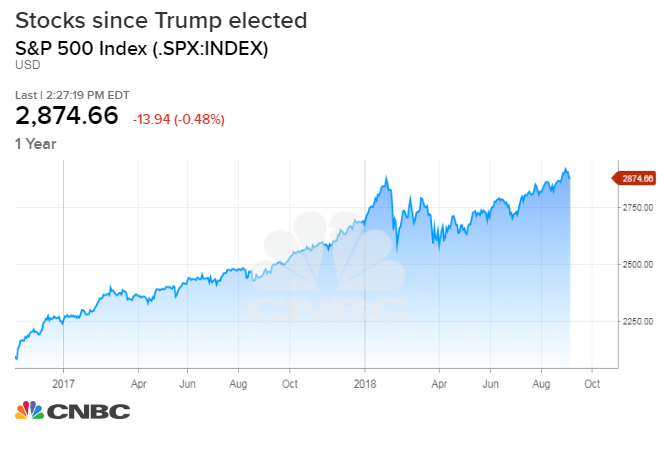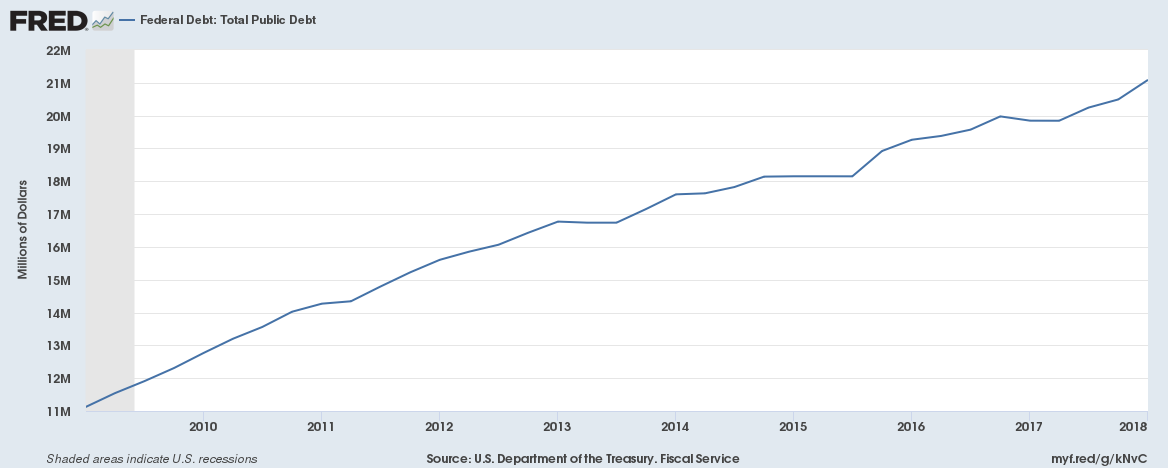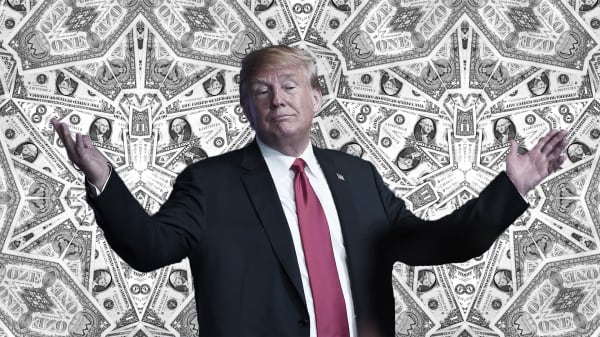Here is how he did it
- President Donald Trump presides over an administration that has seen an enormous level of controversy that could overshadow a burgeoning economy.
- He has delivered on promises to cut taxes and regulations and promote activity through more aggressive government spending.
- Critics believe that it won't last because the fiscal stimulus is aimed only at near-term growth.
- The results, though, have been impressive: a surge in company profits and near-record levels of optimism from consumers and businesses.
President Donald Trump is more than 19 months into an administration engulfed in so much controversy that it may overshadow a tremendous achievement, namely an economic boom uniquely his.
During his time in office, the economy has achieved feats most experts thought impossible. GDP is growing at a 3 percent-plus rate. The unemployment rate is near a 50-year low. Meanwhile, the stock market has jumped 27 percent amid a surge in corporate profits.
Friday brought another round of good news: Nonfarm payrolls rose by a better-than-expected 201,000 and wages, the last missing piece of the economic recovery, increased by 2.9 percent year over year to the highest level since April 2009. That made it the best gain since the recession ended in June 2009.
His critics, a group that includes a legion of Wall Street economists, most Democrats and even some in his own Republican Party, don't believe it will last. They figure the current boom will begin petering out as soon as mid-2019 and possibly end in recession in 2020.

Trump's economic achievements
Each of those accomplishments can be tied either directly to new policies or at least indirectly through a brimming sense of hope from businesses that the White House is back on their side.
"When you look at those confidence indexes, they're telling you something," Kudlow said. "His attitude is, we're not punishing business, we're not punishing success, we want to make things easier to do business and to hire, and I think it's had a very positive effect and a very palpable effect."
GDP most recently gained 4.2 percent in the second quarter, the best performance in nearly four years.
At the same time, the unemployment rate is 3.9 percent, just one-tenth of a percentage point above the lowest level since 1969.
But there are some more telling figures about just how much progress has been made under Trump.
At a time when most economists had been using the term "full employment" to describe the economy, 3.9 million more Americans have joined the ranks of the working during the Trump term. During the same period under former President Barack Obama, employment had fallen by 2.6 million. The economy in total, while still not in breakout mode, has grown by $1.4 trillion through the second quarter under Trump; the same time period for Obama saw a gain of just $481 billion, or a third of Trump's total.
Businesses are investing, consumers are spending and innovation is on the rise as well.

President Donald Trump delivers remarks before signing an executive order on strengthening retirement security in America at Harris Conference Center in Charlotte, NC, August 31, 2018.
How he did it
Skeptics doubt it will last

There also are some pockets of the economy that remain mired in slowness, most notably wage gains. Average hourly earnings have risen just 4.1 percent since January 2017 when Trump took office, barely keeping pace with inflation. (Still, during the same period wages rose just 3 percent under Obama.)
Then there's the Federal Reserve, which cut rates and flooded the financial system with cash during the Obama years. Now it is reversing course and tightening, or raising rates.
"The short answer is the honest answer: Nobody knows," Joe LaVorgna, chief economist for the Americas at Natixis, said in assessing the duration of the Trump bump. "If we generate 3.5 percent this year and generate 3.5 percent next year, that could happen provided the Fed doesn't kill it. Then you're going to say it looks like some of it was Trump. It has to be."
With midterm elections fast approaching, Trump's economic record will be front and center. The strong performance could bolster Republicans' hopes as the GOP tries to hold onto control of both the House and the Senate.
So far, though, the experts have gotten it wrong about Trump.
LaVorgna said the final verdict in assessing the Trump performance is yet to come.
When Obama took criticism for the performance during his years, he often blamed obstructionist Republicans.
If the economy falters now, Trump will have no one to blame but himself.
"It's very hard to disentangle all these effects," he said. "If we do get 3 percent growth, which we haven't had since 2005, you have to give credit where it's due. Whether it lasts, who knows?"
source:>>>>>>>>>>>>>>>Here
One of the penalties for refusing to participate in politics is that you end up being governed by your inferiors. -- Plato (429-347 BC)
TRY THE PATRIOT AD FREE
"FIGHTING FOR FREEDOM AND LIBERTY"
and is protected speech pursuant to the "unalienable rights" of all men, and the First (and Second) Amendment to the Constitution of the United States of America, In God we trust
Stand Up To Government Corruption and Hypocrisy
NEVER FORGET THE SACRIFICES
BY OUR VETERANS
Note: We at The Patriot cannot make any warranties about the completeness, reliability, and accuracy of this information.
Don't forget to follow the Friends Of Liberty on Facebook and our Page also Pinterest, Twitter, Tumblr, and Google Plus PLEASE help spread the word by sharing our articles on your favorite social networks.
LibertygroupFreedom 

The Patriot is a non-partisan, non-profit organization with the mission to Educate, protect and defend individual freedoms and individual rights.
Support the Trump Presidency and help us fight Liberal Media Bias. Please LIKE and SHARE this story on Facebook or Twitter.
WE THE PEOPLE
TOGETHER WE WILL MAKE AMERICA GREAT AGAIN!
Join The Resistance and Share This Article Now!

TOGETHER WE WILL MAKE AMERICA GREAT AGAIN!
Help us spread the word about THE PATRIOT Blog we're reaching millions help us reach millions more.
Help us spread the word about THE PATRIOT Blog we're reaching millions help us reach millions more.
‼️️ ♻️ PLEASE SHARE ♻️ ‼️️
Please SHARE this now! The Crooked Liberal Media will hide and distort the truth. It’s up to us, Trump social media warriors, to get the truth out. If we don’t, no one will!
Share this story on Facebook and let us know because we want to hear YOUR voice!
Facebook has greatly reduced the distribution of our stories in our readers' newsfeeds and is instead promoting mainstream media sources. When you share with your friends, however, you greatly help distribute our content. Please take a moment and consider sharing this article with your friends and family. Thank you
Share this story on Facebook and let us know because we want to hear YOUR voice!
Facebook has greatly reduced the distribution of our stories in our readers' newsfeeds and is instead promoting mainstream media sources. When you share with your friends, however, you greatly help distribute our content. Please take a moment and consider sharing this article with your friends and family. Thank you






No comments:
Post a Comment